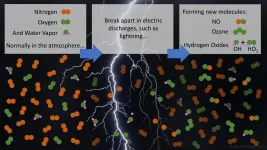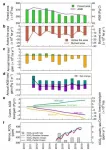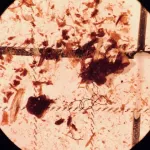Considerable gap in evidence around whether portable air filters reduce the incidence of COVID-19
2021-04-29
(Press-News.org) Considerable gap in evidence around whether portable air filters reduce the incidence of COVID-19 and other respiratory infections
There is an important absence of evidence regarding the effectiveness of a potentially cost-efficient intervention to prevent indoor transmission of respiratory infections, including COVID-19, warns a study by researchers at the University of Bristol.
Respiratory infections such as coughs, colds, and influenza, are common in all age groups, and can be either viral or bacterial. Bacteria and viruses can become airborne via talking, coughing or sneezing. The current global coronavirus (COVID-19) pandemic is also spread primarily by airborne droplets, and to date has led to over three million deaths worldwide.
Controlling how we acquire and transmit respiratory infections is of huge importance, particularly within indoor environments such as care homes, households, schools/day care, office buildings and hospitals where people are in close contact. Several manufacturers of portable air filters have claimed their products remove potentially harmful bacteria and viruses from indoor air, including COVID-19 viral particles. However, there is often no detailed evidence provided on their websites to corroborate their claims for potential consumers to review before purchasing.
A team of UK researchers from the University of Bristol reviewed previous studies to investigate whether portable air filters used in any indoor setting can reduce incidence of respiratory infections and thus, whether there is any evidence to recommend their use in these settings to reduce the spread of COVID-19 and other respiratory infections. The team also explored whether portable air filters in indoor settings capture airborne bacteria and viruses within them, and if so, what specifically is captured.
The researchers found no studies investigating the effects of portable, commercially available air filters on the incidence of respiratory infections in any indoor community setting. Two studies reported removal or capture of airborne bacteria in indoor settings (an office and emergency room), demonstrating that the filters did capture airborne bacteria and reduced the amount of airborne bacteria in the air. Neither tested for the presence of viruses in the filters, nor a reduction in viral particles in the air.
The study, funded by Professor Alastair Hay's National Institute for Health Research Senior Investigator Award and published in PLoS One, was a systematic review of studies published after 2000 reporting (i) effects of portable air filters on incidence of respiratory infection, or (ii) whether filters capture and/or remove aerosolised bacteria and viruses from the air, including information of what is captured. Studies reporting non-portable air filters were excluded from this study.
Lead author, Dr Ashley Hammond, an Infectious Disease Epidemiologist at the Centre for Academic Primary Care, University of Bristol, said: "Our study highlights the considerable gap in evidence related to the effectiveness of portable air filters in preventing respiratory infections, including COVID-19. Whilst we found some evidence suggesting use of air filters could theoretically contribute to reducing the spread of COVID-19 and other respiratory infections by capturing airborne particles, there is a complete absence of evidence as to whether they actually reduce the incidence of these infections."
Professor Alastair Hay, a GP and Professor of Primary Care at the Centre for Academic Primary Care, University of Bristol, and the research group lead, said: "Randomised controlled trials are urgently needed to demonstrate the effects of portable air filters on incidence of respiratory infections, including COVID-19. The main research questions should focus primarily on whether use of portable air filters in any indoor environment can reduce respiratory infections compared to those environments without portable air filters."
INFORMATION:
Paper
Should homes and workplaces purchase portable air filters to reduce the transmission of SARS-CoV-2 and other respiratory infections? A systematic review by Ashley Hammond, Tanzeela Khalid, Hannah V Thornton, Claire A Woodall and Alastair D Hay. Published in PLOS ONE. 29 April 2021.
ELSE PRESS RELEASES FROM THIS DATE:
2021-04-29
Lightning bolts break apart nitrogen and oxygen molecules in the atmosphere and create reactive chemicals that affect greenhouse gases. Now, a team of atmospheric chemists and lightning scientists have found that lightning bolts and, surprisingly, subvisible discharges that cannot be seen by cameras or the naked eye produce extreme amounts of the hydroxyl radical -- OH -- and hydroperoxyl radical -- HO2.
The hydroxyl radical is important in the atmosphere because it initiates chemical reactions and breaks down molecules like the greenhouse gas methane. OH is the main driver of many compositional changes in the atmosphere.
"Initially, we looked at these huge OH and HO2 signals found in the clouds and asked, what is wrong with our instrument?" said William ...
2021-04-29
Researchers in the materials department in UC Santa Barbara's College of Engineering have uncovered a major cause of limitations to efficiency in a new generation of solar cells.
Various possible defects in the lattice of what are known as hybrid perovskites had previously been considered as the potential cause of such limitations, but it was assumed that the organic molecules (the components responsible for the "hybrid" moniker) would remain intact. Cutting-edge computations have now revealed that missing hydrogen atoms in these molecules can cause massive efficiency losses. The findings are published in ...
2021-04-29
An international team led by Xiangming Xiao, George Lynn Cross Research Professor in the Department of Microbiology and Plant Biology, University of Oklahoma College of Arts and Sciences, published a paper in the April issue of the journal Nature Climate Change that has major implications on forest policies, conservation and management practices in the Brazilian Amazon. Xiao also is director of OU's Center for Earth Observation and Modeling. Yuanwei Qin, a research scientist at the Center for Earth Observation and Modeling, is the lead author of the study.
For the study described in the paper, "Carbon loss ...
2021-04-29
As part of a laboratory experiment, Rebecca Holmes examined water bottles that had been acquired from abroad expecting to find bisphenol A (BPA), a human-made component commonly found in polycarbonate plastics used to make consumer products.
What she found, however, was that those water bottles were just fine, yet some control bottles purchased in the United States and supposedly BPA-free actually contained traces of the chemical now thought to negatively impact heart health.
Holmes, a researcher formerly in the laboratory of Hong-Sheng Wang, PhD, professor in the University of Cincinnati Department of Pharmacology and Systems Physiology, was working on her master's degree in molecular, cellular and biochemical ...
2021-04-29
WASHINGTON, D.C. (APRIL 29, 2021) - Results from a new study find a broad range of patients who typically undergo revascularization for stable ischemic heart disease (SIHD) in the U.S. did not meet enrollment criteria for the ISCHEMIA trial. The data, which was presented today as late-breaking clinical science at the Society for Cardiovascular Angiography & Interventions (SCAI) 2021 Scientific Sessions, demonstrates a minority of SIHD patients referred for coronary intervention in contemporary practice clearly resemble those enrolled in the ISCHEMIA trial.
Ischemic heart disease impacts more than 13 million people in the United States and is the leading cause ...
2021-04-29
WASHINGTON, D.C, (April 29, 2021) - An analysis of growth patterns in transcatheter aortic valve replacement (TAVR) programs across United States hospitals is being presented as late-breaking clinical science at the Society for Cardiovascular Angiography& Interventions (SCAI) 2021 Scientific Sessions. The findings indicate that TAVR hospital programs are predominately located in metropolitan areas serving patients with higher socioeconomic status, potentially contributing to the disparities in cardiac care.
TAVR is a minimally invasive procedure for patients in need of a valve repair or replacement and is an alternative to surgical aortic valve replacement (SAVR), a treatment ...
2021-04-29
Washington, D.C., April 29, 2021 - Two studies related to percutaneous coronary intervention (PCI) evaluating the use of risk-avoidance strategies and robotic-assisted technology, respectively, are being presented as late-breaking clinical science at the Society for Cardiovascular Angiography & Interventions (SCAI) 2021 Scientific Sessions. An analysis of strategically avoiding high-risk PCI cases indicates systematic risk-avoidance does not improve, and may worsen, the quality of hospital PCI programs. A study of a robotic-assisted PCI shows the technology is safe and effective for the treatment of both simple and complex lesions; this has the potential to address the occupational ...
2021-04-29
The United Kingdom government plans to implement mass scale population testing for SARS-CoV-2 infection using Lateral Flow Devices (LFDs), yet the devices' sensitivity is unknown. A study published in the open access journal PLOS Biology by Alan McNally at University of Birmingham, UK, and colleagues suggests while LFDs are highly effective in identifying SARS-CoV-2 in individuals with high quantities of viral RNA present on the test swab, they are inaccurate at diagnosing infections in individuals with lower viral loads.
LFDs are increasingly used to increase testing capacity and screen asymptomatic populations for SARS-CoV-2 infection in mass surveillance programs, yet there are few data ...
2021-04-29
Forget diamonds--plastic is forever. It takes decades, or even centuries, for plastic to break down, and nearly every piece of plastic ever made still exists in some form today. We've known for a while that big pieces of plastic can harm wildlife--think of seabirds stuck in plastic six-pack rings--but in more recent years, scientists have discovered microscopic bits of plastic in the water, soil, and even the atmosphere. To learn how these microplastics have built up over the past century, researchers examined the guts of freshwater fish preserved in museum collections; they found that fish have been swallowing microplastics since the 1950s and that the concentration of microplastics in their guts ...
2021-04-29
NASA's Hubble Space Telescope is giving astronomers a rare look at a Jupiter-sized, still-forming planet that is feeding off material surrounding a young star.
"We just don't know very much about how giant planets grow," said Brendan Bowler of the University of Texas at Austin. "This planetary system gives us the first opportunity to witness material falling onto a planet. Our results open up a new area for this research."
Though over 4,000 exoplanets have been cataloged so far, only about 15 have been directly imaged to date by telescopes. And the planets are so far away and small, they are simply dots in the best photos. The team's fresh technique for using Hubble to directly image this planet paves a new route for further exoplanet ...
LAST 30 PRESS RELEASES:
[Press-News.org] Considerable gap in evidence around whether portable air filters reduce the incidence of COVID-19





